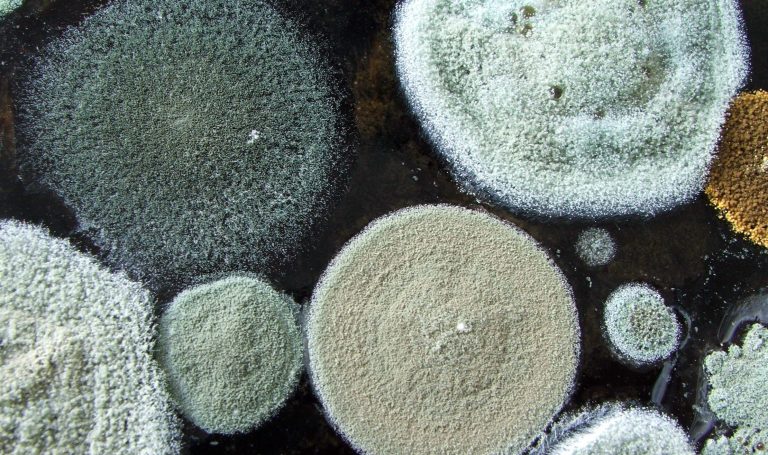Finding mold in your home can leave a nasty feeling in the pit of your stomach, since most of us recognize that mold is a dangerous and expensive issue to deal with. But what is it that makes mold so dangerous in the first place? What are the health risks that should prompt you to seek mold remediation services as quickly as possible?
Mold Basics
Let’s start by discussing some of the basics of mold. Mold is a type of fungus, and there are many different types of molds. This species of fungus reproduces by releasing millions of microscopic spores that float through the air; when these spores meet in conditions of high moisture and still air, they reproduce and begin growing a new fungus.
Chances are, you’re breathing in mold spores right now. Mold comes in innumerable different varieties, many of which are microscopic, harmless, and unnoticeable to the general population. But there are also species of mold that are more apparent, more dangerous, and more destructive in the context of your home.
Mildew is very similar, but it’s worth noting that mildew is distinct from mold. It’s also a fungus, it also thrives in still and moist conditions, but it tends to be easier to get rid of and is associated with milder health effects in many cases.
Health Risks Associated With Mold
So what happens if you’re exposed to mold?
Unfortunately, that’s a complicated question. First, remember that there are many different species of mold. Some types of mold may have almost no effect on human health whatsoever, while other types of mold produce mycotoxins that can lead to severe illness. The types of symptoms you might face will depend on the type of mold and your level of exposure to it.
Also, different people respond to mold in different ways. Some people who are especially tolerant to mold may not notice any symptoms at all, despite living in an environment saturated with it. For others, mold can trigger a wide range of different symptoms.
For example:
· Mild allergy symptoms. Some people notice only mild allergy symptoms when being exposed to mold. They may experience a runny nose, a coughing fit, itchiness, dry eyes, or other such symptoms.
· Moderate allergy symptoms. For other people, these symptoms are more severe. Exposure to mold could lead to symptoms like headache, fatigue, swelling, wheezing, breathing difficulties, or even digestive issues.
· Lung infections. People who are immune-compromised and people with pre-existing lung conditions may be susceptible to lung infection after being exposed to mold. These range from mild to severe, and in some cases, can be life-threatening.
· Mycotoxin illnesses. Certain types of mold produce mycotoxins, which are compounds produced by fungi that are dangerous for humans. If you’re exposed to these mycotoxins, you could develop a serious illness that requires immediate treatment.
What to Do
If you find mold in your house or suspect mold may be present, it’s important to take action.
· Check for mold. Sometimes, mold is obvious; you’ll see large patches of a fuzzy, splotchy material in a color like black, green, dark green, or dark blue. Sometimes, the mold is hidden, infesting the studs in your wall without any external signs. If you want to thoroughly check for mold, it’s important to run some tests, although it’s worth mentioning that mold tests aren’t always perfectly accurate. Mold often appears as a result of untreated, high levels of moisture, so if you’ve experienced any recent leaks or flooding, check those areas specifically. Depending on the situation, it may make sense to cut into your wall and see if there are any signs of mold on the inside.
· Remediate mold. Even if you don’t have many visible signs or symptoms of mold exposure, it’s important to remediate the mold problem as quickly and efficiently as you can to prevent future issues. For best results, you should hire a mold remediation professional. These experienced pros will ensure every bit of the mold is thwarted – and take precautions to prevent it from coming back. Small, relatively innocuous infestations can sometimes be handled with diluted bleach, but more serious infestations require an expert approach.
· Prevent mold from growing back. Next, make sure the mold doesn’t grow back easily. Drying the area and circulating more air are your best options here, so keep your doors and windows open, run fans, and keep dehumidifiers on in the affected areas.
Because mold comes in so many different varieties and it affects people so differently, it’s hard to say precisely or concisely what the effects of mold are. But we do know that mold is often problematic for human health, so it’s important to take precautions to avoid exposure to it.


2 Comments
My apt. building also has black mold. Management just drags their feet and doesn’t want to do anything about it. I’m going to move out of Riverview Apts. The entire building is infested with mold, bedbugs and roaches. Just pay your rent on time. That’s all they care about.
I have been living with black mold for 10 years. Nothing I have tried doesn’t get rid of it. White distilled vinegar cleans it up pretty good but as soon as it starts raining the black mold comes back. I have respiratory issues. For the last two years I have been sick almost every day. My allergies are out of control. I have real bad stomach issues. Black mold is the cause of most of my health issues.